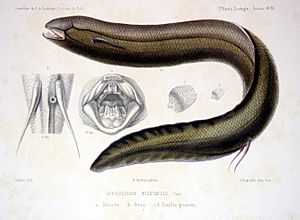South American lungfish facts for kids
Quick facts for kids South American lungfish |
|
|---|---|
 |
|
| Conservation status | |
| Scientific classification | |
| Genus: |
Lepidosiren
|
| Species: |
paradoxa
|
| Synonyms | |
|
(Genus)
(Species)
|
|
The South American lungfish (Lepidosiren paradoxa) is a special type of lungfish. People also call it the American mud-fish or scaly salamanderfish. It is the only species in its family, called Lepidosirenidae. This fish lives in swamps and slow-moving rivers in South America. You can find it in the Amazon, Paraguay, and lower Paraná River areas.
This fish is unique because it is an obligate air-breather. This means it must breathe air to live, unlike most fish that only breathe underwater. In Brazil, people call it piramboia, which means "snake-fish" in the Tupi language.
Contents
About the South American Lungfish
The South American lungfish is closely related to the African lungfishes. Scientists believe these two groups of fish started to become different species during the Early Cretaceous period.
What the Lungfish Looks Like
When they are young, South American lungfish have gold spots on a black body. As they grow older, their color changes to brown or gray. Like all lungfishes, their jaw bones are joined together. They also have strong jaw muscles.
This fish has a long, thin body, almost like an eel. It can grow up to about 4 feet (125 cm) long. Its pectoral fins are very thin and look like threads. The pelvic fins are a bit bigger and are located far back on its body. A cool fact is that its fins connect to the shoulder with just one bone. This is very different from most fish, but similar to animals that live on land! Adult lungfish have very small gills that do not work well for breathing. This is why they need to breathe air.
What the Lungfish Eats
Young lungfish like to eat insect larvae and snails. Adult lungfish are omnivores, meaning they eat both plants and animals. They add algae and shrimp to their diet. They have strong, hard tooth-plates to crush their food.
How the Lungfish Survives Dry Seasons
The places where these fish live often dry up during the dry season. To survive, the lungfish burrows into the mud. It makes a special chamber about 12 to 20 inches (30 to 50 cm) deep. It leaves a few small holes to the surface so it can breathe air.
During this time, called aestivation, the fish produces a layer of mucus. This mucus helps seal in moisture and keeps the fish from drying out. The fish also slows down its body processes a lot. This helps it save energy until the water returns.
Reproduction and Life Cycle
Not much is known about the South American lungfish's life. They have special body parts that help them deal with both droughts (dry periods) and floods (wet periods). When the rainy season starts, they come out of the mud and begin to mate.
The parent fish build a nest for their young. The baby lungfish look like tadpoles and have four external gills. To make sure the babies have enough oxygen in the nest, the male fish grows special blood-rich structures on his pelvic fins. These structures release extra oxygen into the water. The young fish start breathing air when they are about seven weeks old. Young lungfish have external, thread-like gills, much like newts.
Ancient History
Scientists have found fossils of this modern lungfish species. These fossils are between 72 and 66 million years old. They were found from the Maastrichtian stage of the late Cretaceous period. This was just before the KPG extinction that caused the non-avian dinosaurs to die out.
See also
 In Spanish: Pez pulmonado para niños
In Spanish: Pez pulmonado para niños




